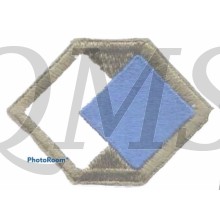Mouwembleem 96th Infantry Division (Sleeve patch 96th Infantry Division)
The 96th Sustainment Brigade, formerly the 96th Infantry Division is a unit of the United States Army that served in World War II.
The division was first organized in October 1918, during the U.S. mobilization for World War I. The division was organized in the First World War "National Army" on 20 October 1918 at Camp Wadsworth, South Carolina. The 96th was one of the last divisions activated and the war ended before it could be sent overseas. It was thus demobilized on 7 January 1919. The division was reconstituted in the Organized Reserves on 24 June 1921 at Portland, Oregon.
As part of the reorganization of the U.S. Army divisions from "square" to "triangular," the two infantry brigade headquarters were converted to provide personnel for other units and the 380th Infantry Regiment was disbanded. The 192nd Infantry Brigade headquarters company was converted into the division's 96th Reconnaissance Troop, while the 191st Infantry Brigadeheadquarters formed the core of the division's headquarters company. After initial training at Camp White in southern Oregon, the 96th Infantry Division participation in the Oregon Maneuvercombat exercise in the fall of 1943.
The division trained in Hawaiian Islands from July to September 1944 before entering combat in an assault landing in Leyte Gulf, Philippine Islands, between Tanauan and Dulag, 20 October 1944. Enemy resistance in the beachhead area was quickly broken and the division had advanced to and secured the Tanauan-Dagami-Tabontabon sector by 9 November after heavy fighting. The division continued to wipe out resistance on the island, engaging in small unit actions, patrolling, probing, and wiping out pockets of Japanese. Chalk Ridge was taken 12 December 1944, and major organized resistance was at an end by Christmas Day. The next three months were spent in mopping up, security duty, training, and loading for the coming invasion of Okinawa.
The division left the Philippines 27 March 1945 for Okinawa, making an assault landing on the island on 1 April. The landing was unopposed and a beachhead was established, between 1 to 3 April 1945. Resistance stiffened considerably as the division advanced to Kakazu Ridge, where fighting was fierce, from 7 to 16 April 1945. The 96th assaulted and cracked the fanatically-defended enemy defense line, Tanabaru Nishibaru, 17–23 April, and after advancing slightly against extremely determined resistance, was relieved on 30 April by the 77th Infantry Division. The division trained and rested 1–9 May, while elements mopped up bypassed enemy pockets and then returned to the offensive, 10 May 1945, attacking and capturing Conical-Sugar Hill Ridge, 21 May, thus breaking the right flank of the Shuri defenses. Heavy rains the following week slowed down the advance. The offensive was resumed, 30 May, against weakening enemy resistance; Japanese north of Yonabaru-Shuri-Naha Road area were cleared out. Resistance stiffened again, 3 June, and Laura Hill was taken, 14 June 1945, only after a bloody fight; the last important Japanese defense position, the Yuza-Dake, Yaeju-Dake Hill mass, was secured by 17 June, and on 22 June all resistance was declared at an end.Many of the landmark names and other locations of the massive engagement have been changed by modern Japanese.
The division patrolled an area from Chan to Ogusuku until 30 June. After resting in July, the division left Okinawa for Mindoro, in the Philippines, and engaged in a training program. The division left the Philippines, 17 January 1946, for the United States.



